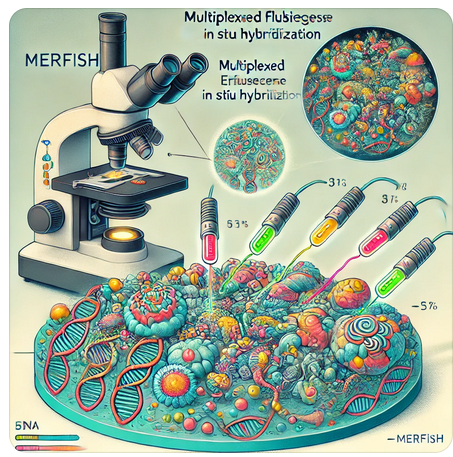MERFISH (Multiplexed Error-Robust Fluorescence In Situ Hybridization) is an advanced imaging technique for visualization and quantitating RNA molecules in cells and tissues with high spatial resolution, allowing mapping gene expression at single-cell resolution.MERFISH represents a powerful tool for studying complex RNA dynamics in biological systems. MERFISH combines in situ hybridization methods by tagging specific nucleic acids within cells or tissues with multiplexed barcoding to visualize thousands of RNA molecules simultaneously.
Bio-Synthesis specializes in high-quality fluorescent dyes and labeling solutions, particularly for MERFISH applications! Using cleavable linkers and offering single or double dye labeling, as well as dual HPLC purification, really speaks to the high standards for both research and ISO13485 GLP-grade products.
All Merfish read-out probe are dual HPLC purified.

Major features of MERFISH:
Multiplexing: MERFISH's unique ability to detect thousands of RNA species in a single sample provides a practical and comprehensive view of gene expression profiles, making it an invaluable tool for researchers.
Error-Robustness: MERFISH employs error-correcting codes, which enhance the accuracy of RNA detection by compensating for potential misreads or overlaps in fluorescent signals.
Spatial Resolution: MERFISH maintains high spatial resolution, allowing researchers to map the location of RNA molecules within the context of tissue architecture.
Applications: Various scientific fields utilize MERFISH, including developmental biology, neuroscience, and cancer research. MERFISH IS a powerful tool for studying gene expression patterns, cellular heterogeneity, and spatial organization.
Workflow: MERFISH typically involves hybridizing fluorescently labeled probes to RNA targets, imaging the sample multiple times to capture the different probes, and then using computational methods to decode the signals.
Major Applications are:
Single-Cell Transcriptomics and Cellular Atlases
- Mapping Cellular Diversity: MERFISH can profile thousands of genes at the single-cell level in tissues, allowing researchers to identify and catalog distinct cell types and states within complex tissues, such as the brain, liver, or tumors.
- Cellular Atlas Projects: MERFISH contributes to large-scale projects like the Human Cell Atlas, aiming to map the spatial organization of every cell type in the human body.
Neuroscience Research
- Brain Structure and Function: MERFISH allows expression pattern mapping of thousands of genes across large brain regions to improve our understanding of complex neural circuits, cellular diversity in the brain, and the molecular basis of behavior and cognition.
- Neurodegenerative Diseases: In diseases like Alzheimer's and Parkinson's, MERFISH helps study gene expression changes in various cell types, providing insights into disease progression and potential therapeutic targets.
Cancer Research and Tumor Microenvironment
- Tumor Heterogeneity: MERFISH maps gene expression within tumors, revealing cellular heterogeneity, which is crucial for understanding cancer biology, tumor evolution, and resistance to therapies.
- Tumor Microenvironment: It enables spatial mapping of cancer cells and surrounding immune and stromal cells, helping researchers understand interactions between cancer cells and their microenvironment, which can influence disease progression and response to treatment.
Developmental Biology
- Embryonic Development: By mapping gene expression in developing embryos, MERFISH can reveal how spatially organized gene expression drives cell differentiation and tissue formation.
- Organogenesis Studies: Researchers use MERFISH to study how cells organize and communicate to form organs, providing insights into developmental disorders and regenerative biology.
Immunology and Infectious Diseases
- Immune Cell Profiling: MERFISH helps in profiling immune cells in tissues mapping immune responses in the context of infections or autoimmune diseases.
- Pathogen-Host Interactions: MERFISH can be used to study how pathogens influence gene expression in host cells and tissues, providing valuable insights for developing treatments.
Spatial Genomics in Disease Mechanisms
- Genetic Disorders: MERFISH enables detailed studies of gene expression changes in tissues affected by genetic disorders, helping to understand underlying molecular mechanisms.
- Precision Medicine: By mapping gene expression changes in response to treatments within tissues, MERFISH aids in precision medicine efforts, potentially guiding personalized therapy decisions based on spatial transcriptomic profiles.
Drug Discovery and Therapeutic Development
- Target Validation: MERFISH can validate potential drug targets by mapping their expression across tissues and identifying where in the body and in which cell types they are active.
- Drug Effects on Tissue: It enables detailed studies of how drugs impact specific cell types and gene expression patterns in tissues, helping to assess efficacy and potential side effects.
References:
Asp M, Bergenstrahle J, Lundeberg J. Spatially resolved transcriptomes‐next generation tools for tissue exploration. Bioessays. 2020;42(10):e1900221.[PubMed]
Chen KH, Boettiger AN, Moffitt JR, Wang S, Zhuang X. RNA imaging. Spatially resolved, highly multiplexed RNA profiling in single cells. Science. 2015;348(6233):aaa6090. [PMC]
Codeluppi S, Borm LE, Zeisel A, et al. Spatial organization of the somatosensory cortex revealed by osmFISH. Nat Methods. 2018;15(11):932‐935.[PubMed]
Eng CL, Lawson M, Zhu Q, et al. Transcriptome‐scale super‐resolved imaging in tissues by RNA seqFISH. Nature. 2019;568(7751):235‐239.[PMC]
Lubeck E, Coskun AF, Zhiyentayev T, Ahmad M, Cai L. Single‐cell in situ RNA profiling by sequential hybridization. Nat Methods. 2014;11(4):360‐361.[PMC]
Park HE, Jo SH, Lee RH, et al. Spatial transcriptomics: technical aspects of recent developments and their applications in neuroscience and cancer research. Adv Sci (Weinh). 2023;10(16):e2206939. [PMC]
Shah S, Lubeck E, Schwarzkopf M, et al. Single‐molecule RNA detection at depth by hybridization chain reaction and tissue hydrogel embedding and clearing. Development. 2016;143(15):2862‐2867.[PMC] [PubMed]
Xia C, Fan J, Emanuel G, Hao J, Zhuang X. Spatial transcriptome profiling by MERFISH reveals subcellular RNA compartmentalization and cell cycle‐dependent gene expression. Proc Natl Acad Sci USA. 2019;116(39):19490‐19499.[PMC] [PubMed]
Wang N, Hong W, Wu Y, Chen ZS, Bai M, Wang W, Zhu J. Next-generation spatial transcriptomics: unleashing the power to gear up translational oncology. MedComm (2020). 2024 Oct 6;5(10):e765.[PMC]
(Vizgen, the MERFISH Company)
Vizbi Poster: Web based Visual Exploration of the Mouse Liver at Single-Cell Resolution with Vizgen MERFISH Open Data Set - Vizgen. https://vizgen.com/resources/vizbi-poster-web-based-visual-exploration-of-the-mouse-liver-at-single-cell-resolution-with-vizgen-merfish-open-data-set/ (Source: https://vizgen.com/)